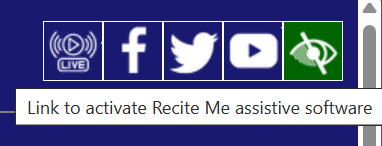When I recently reviewed content management systems used by councils (in the UK and Ireland) I was struck by just how many council websites seemed to be using accessibility overlays (also known as accessibility or assistive toolbars). I therefore carried out some additional research to check this. I was aware that concerns have been raised about this technology, so I decided to find out which councils are using them, what products they are using and try to explore a little about why they choose to use them. The aim of this blog post is to spark discussion and to encourage councils that are using them to revisit their use – that is assuming of course that they haven’t already done so.
What are accessibility toolbars and overlays?
An overlay relates to a toolbar or plugin which is added to a website to try to improve its accessibility. Website add-on products claiming to improve accessibility go back to the late 1990s with products like Readspeaker and Browsealoud. 1
Overlays generally appear as a clickable button on a website that brings up a range of controls. These controls let you change the visual appearance of the webpage or enable the website to be read out or translated into other languages. Controls may also include:
- adjusting the font size or type
- changing the contrast between text and background colours
- screen masks
- generating an MP3 of text
How many councils use accessibility overlays?
My research reveals that 104 councils or around 25% of all councils in UK and Ireland are currently using an overlay.
Accessibility overlay providers (UK and Ireland)
ReachDeck and ReciteMe lead a small group of four accessibility overlay providers as shown in the table below. For more details of the councils using these providers take a look at the Airtable presented at the end of this blog post. To search by council simply select the Extensions option on the Airtable menu and use the search option presented.
| Accessibility toolbar provider | Number of councils |
| ReachDeck (formerly known as Browsealoud). | 54 |
| ReciteMe | 45 |
| ReadSpeaker | 4 |
| UserWay | 1 |
| Total of councils using overlays | 104 |
| Total of councils not using overlays | 305 |
What concerns have been raised about overlays?
A growing number of articles have been written voicing concerns about using overlays. I have summarised the main concerns and referenced the sources in the footnotes below.
In brief it is claimed that overlays:
- can fix minor problems but not serious user experience issues
- conflict with and override a user’s existing assistive technologies like screen readers
- do not compare to manual accessibility audits
- do not work well on mobile
- do not offer an equal website experience for disabled users 2
- will not get you to 100% compliance … or even close3
- require activation to work4
- will hinder your website performance5
Do overlays enhance the overall accessibility of a council website?
I have pondered this question at length and cannot find much evidence to suggest that an overlay enhances the overall accessibility of a council website. Overlays provide a range of features which can help people with specific needs, such as to increase the size of text, change the colour contrast or have text read out to them. Overlays can fix minor problems, but not resolve serious user experience issues. Implementing an overlay does not magically make a council website fully compliant with accessibility guidelines.
During my research I was curious to see if I could find out more about the compliancy or otherwise of council websites using overlays. I decided to check out council websites using overlays using an excellent resource called the Silktide Index.
The Silktide Index evaluates the web accessibility of organizations and assigns them a score based on their level of compliance with Web Content Accessibility Guidelines. I checked out council websites with overlays using Silktide’s UK Councils – Silktide Index and Republic of Ireland Councils – Silktide Index respectively. I reviewed the current month’s index listings (October 2023) and noted down the scores and ranking of each council currently using an accessibility overlay.
I found that 19% (19 out of the 102) councils with overlays listed on the Silktide Index scored highly (95% or above) and were either meeting compliancy or well on the way towards it. Amongst these councils there were some notable exemplars, namely Merthyr Tydfil County Borough Council, ranked joint first in the Silktide UK Councils listing and Offaly County Council, ranked overall first in the Silktide Republic of Ireland Councils listing. These councils are to be applauded for their achievement.
Working down the rankings I found that 20% (21 councils scoring between 90% and 94%) on the two Index listings mentioned above. Although these are very good scores these councils still have a fair amount of work to do to meet accessibility compliancy.
I found that 61% (62 out of the 102 councils) with overlays listed on the Silktide Index scored between 20% and 89% and have a lot of work to do to fix accessibility issues. Overlays are clearly not helping these councils with meeting accessibility compliance.
In the UK Councils listings 19% (19 councils with overlays) were placed well down in the bottom quarter (ranked between 302nd and 371st places). Ranking isn’t everything of course, but these councils are clearly struggling with accessibility.
The performance of councils with overlays in the Silktide Index is quite variable. A small number are excelling, but there is nothing to suggest that this has anything to do with having an overlay on their website. I believe that these websites would still be excelling even if they removed their overlays. That they continue to use an overlay simply reflects their strong focus on accessibility and a desire to make their websites open to all.
If your council website has accessibility issues then they need to be identified, reviewed and fixed. From my experience in local government I think that fixing accessibility issues is a generally a lengthy ongoing task, rather than something that can be quickly or easily resolved. You have to play the long game and put the time and effort in to make sure that your website is fully compliant with Web Content Accessibility Guidelines.
Why do councils choose to use an accessibility overlay?
Whilst researching this topic I reached out to councils using overlays via LocalGovDigital Slack and LocalGov Drupal Slack respectively to encourage council colleagues to share their thoughts. Many thanks to those who took the time to get in contact and provide some useful feedback.
Reasons shared for using an overlay include:
- meeting the needs of multi-cultural communities by providing all information in different languages
- providing convenient accessibility options for our users
- although not essential overlays do seem to be useful for some people and gives them the option to customise content to meet their needs in a way that even a WCAG compliant site doesn’t
I was pleased to hear that some councils are actively reviewing their use of overlays and have carried out user testing to ensure that they meet the needs of people with disabilities. Those who are carrying out ongoing user testing have said that they will address any problems as they are encountered. I fear, however, that user testing of overlays may be the exception, rather than the rule.
Accessibility overlays were popular in the 1990s when the knowledge of how to fix and resolve issues was relatively limited. Having implemented an overlay I can fully understand how it may have slipped out of consciousness over time and become a resource that is provided in the background, without being periodically reviewed. That said I would encourage councils to bring overlays into focus and consider them alongside broader requirements for improving the accessibility of their websites. Every third party application associated with a website needs to be periodically reviewed, however useful it might have been in the past.
I was interested to hear from colleagues in local government that some councils have already reviewed their use of overlays and have decided not to use them any longer. This was as a result of reading about the concerns detailed above, but also because they have found out that those who use assistive technology are likely to use their own rather than using one provided by the council.
A lack of knowledge, skills and resources to meet accessibility might also partly explain why overlays were first introduced by councils. Under pressure to meet accessibility requirements councils looked for what seemed to be immediate and visible solutions to an issue. Overlays were also a way to make a outward facing statement to their residents that they take accessibility seriously. Fixing accessibility issues in the background may be more valuable, but this work is essentially hidden.
How are councils presenting the use of overlays?
My research reveals that councils present overlays in many different ways. For example via:
- an icon
- a listen and translate link on the page footer
- a read out and translate link on the page header
- an accessibility link on the page header and / or footer
- an accessibility tools and translation link on the page header and / or footer
- an enable accessibility tools link on the page header
- an audio visual tools link on the page header
I found the use of icons and links to be inconsistent and usability to be variable. One of the better examples was from South Holland District Council, which when selecting the Accessibility toolbar link on the page header takes you to a page which provides some information on the toolbar before prompting you to activate it:

I found other icons not as helpful, such as the Me icon used by Laois County Council to launch ReciteMe and the eye icon also used by Orkney Islands Council to launch their overlay. Sadly the eye icon on the Orkney Islands Council website doesn’t launch the ReciteMe overlay:

to launch ReciteMe.

A few councils referred to Browsealoud when referring to ReachDeck, Browsealoud being the former name for this overlay (see examples from Newham Council and Bridgend Council respectively below). I found this to be rather confusing and would suggest that they need to amend the name given to their overlays to something that is descriptive rather than relating to the product name:


Conclusions
A quarter of councils in the UK and Ireland are currently using accessibility overlays. Whilst overlays can fix some issues they really do not help councils to meet the legal requirements of accessibility compliance. If your council hasn’t or isn’t already reviewing the use of overlays then this is a good time to start.
Footnotes
- Overlay Fact Sheet ↩︎
- Scope: Why accessibility overlays do not improve site accessibility ↩︎
- Gina Bhawalkar, Principal Analyst, Forrester: What’s wrong with quick-fix products for digital accessibility ↩︎
- Cheryl Swan, HeX Productions: Setting the record straight: a guide to accessibility overlays ↩︎
- Siteimprove: A guide to accessibility overlays ↩︎
Airtable – Accessible overlay usage by councils in UK and Ireland
I will continue to update the Accessibility overlay Airtable below as and when I find out about any changes. If you spot any errors or want to report any changes please do get in contact. I am currently researching the online promotion of British Sign Language (BSL) and text relay by councils in the UK and Ireland. Watch out for my next blog post which will be published in November 2023.
If you need any help with reviewing the performance of your website please do get in contact to discuss your needs.

